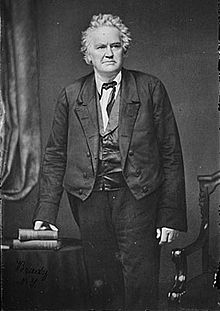Joshua Reed Giddings
| Joshua Reed Giddings | |
|---|---|

Photograph by Mathew Brady's studio (1855 – 1864)
|
|
| Member of the U.S. House of Representatives from Ohio's 16th district |
|
|
In office December 3, 1838 – March 3, 1843 |
|
| Preceded by | Elisha Whittlesey |
| Succeeded by | James Mathews |
| Member of the U.S. House of Representatives from Ohio's 20th district |
|
|
In office March 4, 1843 – March 3, 1859 |
|
| Preceded by | New District |
| Succeeded by | John Hutchins |
| Member of the Ohio House of Representatives | |
|
In office 1826–1827 |
|
| Personal details | |
| Born |
October 6, 1795 Tioga Point, Pennsylvania |
| Died | May 27, 1864 (aged 68) Montreal, Province of Canada |
| Resting place | Oakdale Cemetery, Jefferson, Ohio |
| Political party | |
| Signature | |
Joshua Reed Giddings (October 6, 1795 – May 27, 1864) was an American attorney, politician and a prominent opponent of slavery. He represented Ohio in the U.S. House of Representatives from 1838 – 59. He was at first a member of the Whig Party and was later a Republican, helping found the party.
Giddings was censured in 1842 for violating the gag rule against discussing slavery in the House of Representatives when he proposed a number of Resolutions arguing against federal support for the coastwise slave trade, in relation to the Creole case. He quickly resigned, but was overwhelmingly re-elected by his Ohio constituents in a special election to fill the vacant seat. He returned to the House and served a total of nearly twenty more years as representative.
Joshua Reed Giddings was born at Tioga Point, now Athens, Bradford County, Pennsylvania, on 6 October 1795. In 1806 his parents Elizabeth (née Pease) and Joshua Giddings moved the family to Ashtabula County, Ohio, which was then sparsely settled. Here they settled on Ohio's Western Reserve, where Giddings lived for most of the rest of his life. Many settlers from New England went there. As the Reserve was widely famous for its radicalism, Giddings may have been inspired in his first stirrings of passion for antislavery.
Giddings worked on his father's farm and, although he received no systematic education, devoted much time to study and reading. As a teenager he joined a militia regiment for the War of 1812. He served for five months, including battles against American Indian allies of the British.
...
Wikipedia
